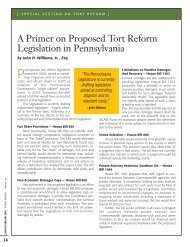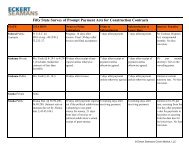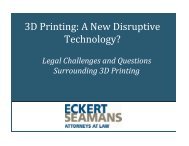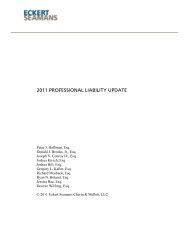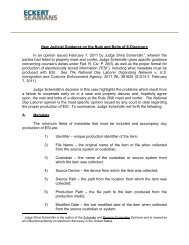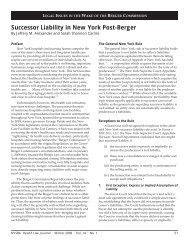2012 PROFESSIONAL LIABILITY UPDATE - Eckert Seamans
2012 PROFESSIONAL LIABILITY UPDATE - Eckert Seamans
2012 PROFESSIONAL LIABILITY UPDATE - Eckert Seamans
You also want an ePaper? Increase the reach of your titles
YUMPU automatically turns print PDFs into web optimized ePapers that Google loves.
complete bar to recovery. Since a legal malpractice action is based on monetary loss, rather thanbodily injury or damage to property, it is outside the scope of the Comparative Negligence Actand the doctrine of Contributory Negligence applies. The Comparative Negligence statute is notapplicable to claims brought to recover pecuniary loss.L. SubrogationIn a case of first impression, the Pennsylvania Supreme Court in Poole v. Workers’Compensation Appeal Board (Warehouse Club, Inc.), 810 A.2d 1182 (Pa. 2002), held thatproceeds from a legal malpractice action are subject to subrogation pursuant to 77 Pa. Cons. Stat.§ 671. Plaintiff Poole was injured when he slipped on a patch of ice in front of his employer’sbuilding. Poole received worker’s compensation benefits from his employer. Poole attempted tofile a complaint against the owner of the property on which he fell, but his attorney filed thecomplaint against the wrong persons. The complaint was dismissed and Poole’s cause of actionagainst the owner was barred by the statute of limitations.Poole filed a legal malpractice action against his former counsel. The malpractice actionsettled and Poole’s employer sought subrogation from the proceeds of the settlement for theamounts it had paid. The Supreme Court held that the employer was entitled to subrogationunder 77 Pa. Cons. Stat. § 671, which provides for subrogation where the compensable injury iscaused in whole or in part by the act or omission of a third party. Because a plaintiff mustdemonstrate not merely an injury as a result of the negligence of his former attorney, but also thenegligence of the third party which resulted in the underlying injury, an employer may rely onthe employee’s legal malpractice action to demonstrate that the compensable injury was causedby a third party. Id.M. VenueIn Zampana-Barry v. Donaghue, 921 A.2d 500 (Pa. Super. Ct. 2007), appeal denied, 596Pa. 709, 940 A.2d 366 (Pa. 2007), the Superior Court affirmed the trial court’s order refusing totransfer venue in a legal malpractice case from Philadelphia to Delaware County. Plaintiff in thiscase brought claims in the Philadelphia Court of Common Please against a lawyer who hadrepresented her in personal injury against K-Mart and who she claimed had negligently failed topreserve her right to proceed against K-Mart after it filed for bankruptcy. Defendants, the lawyerand his firm, filed preliminary objections arguing that venue was improper pursuant to Rules1006(b) and 2179(a)(2) of the Pennsylvania Rules of Civil Procedure, which pertain to venueover a corporation or similar entity. After conducting a hearing, the trial court determined thatDefendants regularly conducted business in Philadelphia and overruled the objections.On appeal the Superior Court first noted that it was unable to ascertain if Defendant lawfirm was a corporation or a partnership and further noted that Rule 2130 contains the provisionsrelating to venue over partnerships and Rule 2179 the provisions relating to venue overcorporations. Both rules, however, allow for venue in a county where the entity “regularlyconducts business” and so the court’s ignorance on this point did not impact the appeal.The court next noted that although Defendants voiced many arguments relating to arequest to transfer venue based on forum non conveniens, i.e. under Rule 1006(d), their motion164




